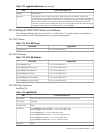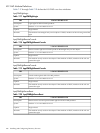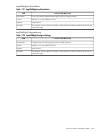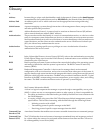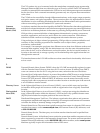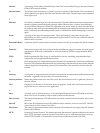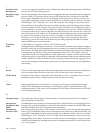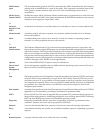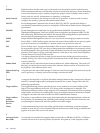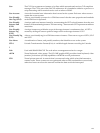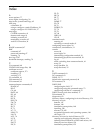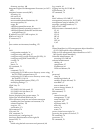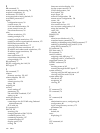MAP address
space
This is the hierarchical graph of the UFiTs contained in the MAP’s AdminDomain. Each instance
starting at the AdminDomain is a node in the graph. Each supported association forms a link
in the graph to another instance node, and so on, until a terminating instance node is
encountered.
Media Access
Control (MAC)
Worldwide unique, 48-bit, hardware address number that is programmed in to each local area
network interface card (NIC) at the time of manufacture. In the Ethernet standard, every network
connection must support a unique MAC value.
N
Network
Interface Card
(NIC)
An internal circuit board or card that connects a workstation or server to a networked device.
Network mask A number used by software to separate a local subnet address from the rest of an Internet
Protocol (IP) address.
Node An addressable point or device on a network. A node can connect a computing system, a
terminal, or various peripheral devices to the network.
O
Onboard
Administrator
The Onboard Administrator (OA) is the enclosure management processor, subsystem, and
firmware base used to support HP Integrity server blades and all the managed devices contained
within the enclosure. The OA provides a single point from which to perform basic management
tasks on server blades or switches within the enclosure. Utilizing this hardwired information,
OA performs initial configuration steps for the enclosure, allows for run time management and
configuration of enclosure components, and informs administrators about problems within the
enclosure through e-mail, SNMP, or the Insight Display.
Options Used in the SMASH SM CLP. Options control verb behavior.
Out-of-band
System
Management
Server management capability that is enabled when the operating system network drivers or
the server are not functioning properly.
P
Port The location (socket) where Transmission Control Protocol/Internet Protocol (TCP/IP) connections
are made. Web servers traditionally use port 80, the File Transfer Protocol (FTP) uses port 21,
and telnet uses port 23. A port enables a client program to specify a particular server program
in a computer on a network. When a server program is started initially, it binds to its designated
port number. Any client that wants to use that server must send a request to bind to the
designated port number.
Port Number A number that specifies an individual Transmission Control Protocol/Internet Protocol (TCP/IP)
application on a host machine, providing a destination for transmitted data.
POST Power-On Self-Test. The series of steps that the host system CPU performs following power-on.
Steps include testing memory, initializing peripherals, and executing option ROMs. Following
POST, the host ROM passes control to the installed operating system.
Properties Properties are attributes that are relevant to a target that are passed as parameters to the
command. Property keywords map to properties of CIM class.
Protocol A set of rules that describes how systems or devices on a network exchange information.
Proxy A mechanism whereby one system acts on behalf of another system in responding to protocol
requests.
R
Remote System A system other than the one on which the user is working.
191



